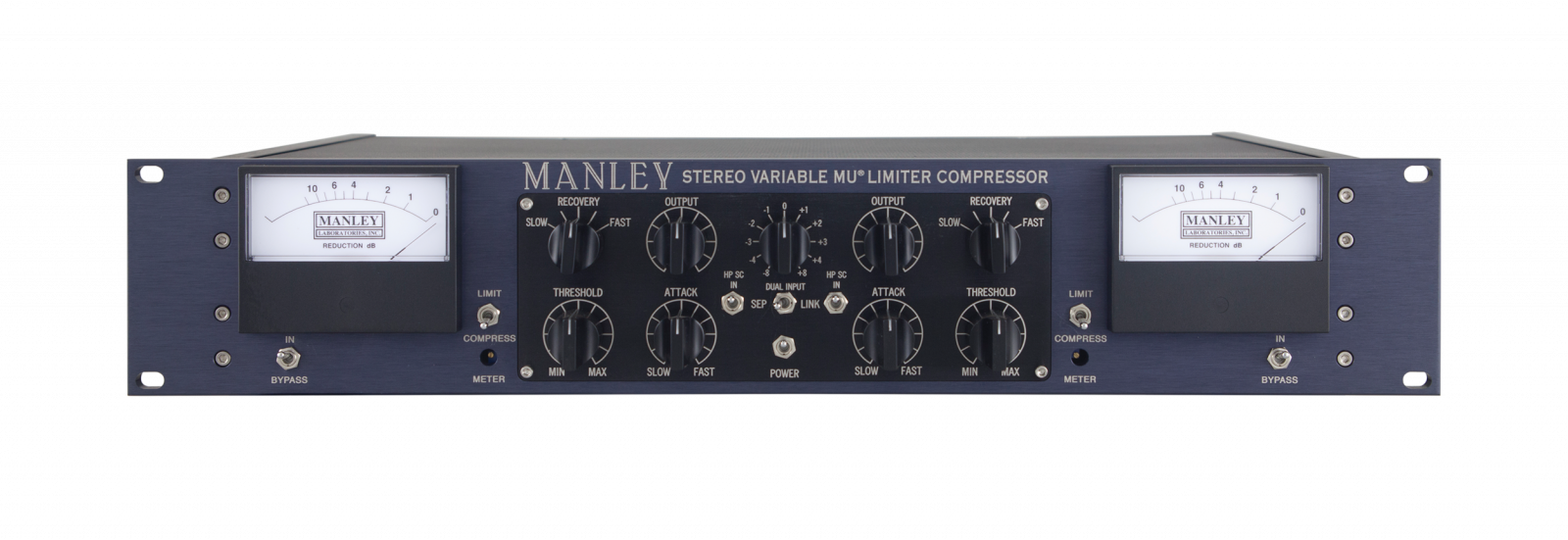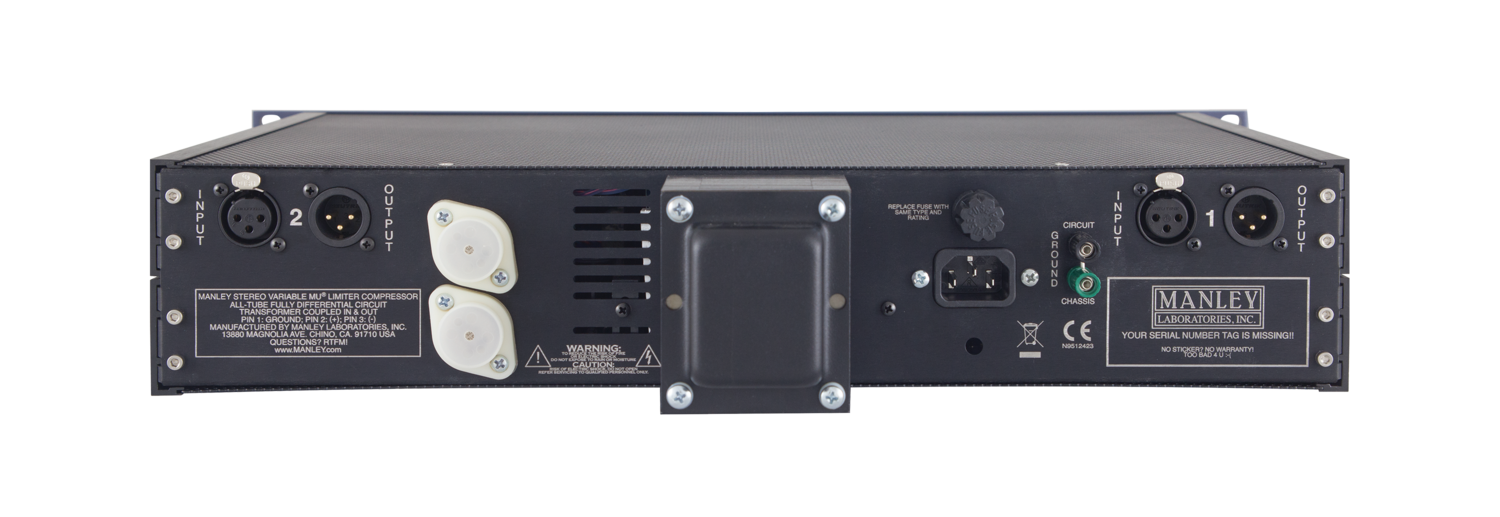Vragen? Betere prijs gezien?
Bel 0512 - 340457 of neem contact op!
Product omschrijving
STEREO VARIABLE MU®
LIMITER COMPRESSOR
The Variable Mu Limiter Compressor is the GLUE that holds the mix together while crystallizing it into a professional, final product. All-tube, all transformer, an all-American legend. High Pass Side Chain mod now comes standard.
DETAILS
The MANLEY VARIABLE MU® LIMITER COMPRESSOR has been our best selling product for many years. It is one of the very few compressors that has become a real standard in Mastering studios and contributed to most hit records over the last decade and probably the next. "Mu" is tube-speak for gain, and Variable Mu® is our registered trademark for this limiter compressor. It works by using the "remote cut-off" or re-biasing of a vacuum tube to achieve compression. The precious vintage Fairchild 670 also uses this technique and is one of few all-tube compressor to do so, that we know of. Even the side-chain has glowing rectifier bottles. How’s it work? The unique 5670 dual triode is at the center of the peak-reducing and compression action constantly being re-biased by the vacuum tube rectified side-chain control voltages which cause this tube to smoothly change its gain. Just like that.
The COMPRESS mode is soft-knee 1.5 to 1 ratio while the sharper knee LIMIT mode starts at 4 to 1 and moves to a more dramatic ratio of 20 to 1 when limiting over 12dB. Interestingly, the knee actually softens as more limiting is used. Distortion can be creatively used by turning up the Input and turning down the Output while using very little or no compression. See the gain reduction curves here!
You might notice that the Variable Mu® Limiter Compressor has a ganged input control, but do not jump to conclusions that it is mono-unfriendly. Track away! There are separate threshold and output controls to make compensations with plus you can always adjust your individual source levels elsewhere, right? The advantage of the stereo input control becomes dramatically clear when you switch to LINK mode, and that’s what our Variable Mu® Limiter Compressor does better than anything else: final mix, 2-track, or mastering limiting and compression. Like one reviewer put it: “It’s like pouring a bowl of sweet cream over the mix.” Mmmmmm. Yummy. Give your music a big hug.
SPECIFICATIONS
- MANLEY input & output transformers with nickel laminations in mu-metal cases with flat frequency response from 20Hz-25KHz
- BALANCED INPUTS & OUTPUTS (600 Ohms)
- Fully differential ALL-TUBE circuitry
- Variable Gain vacuum tube: 5670 x2 Standard or 6BA6 x4 T-BAR Mod
- Amplifying vacuum tubes: 5751 or 12AX7 x2
- Output vacuum tubes: 12BH7 x2 current production since 4/2016
- Output vacuum tubes: prior to MSLC94006 use 7044 or 5687 x2
- Side Chain Rectifier Diodes: 12AL5 x2
- Independently regulated B+ and Heater supplies
- Hardwire BYPASS switch
- Stepped switch INPUT attenuator as of 10/2011. (older units use Silent dual-ganged potentiometer)
- RECOVERY 5 steps: 0.2s, 0.4s, 0.6s, 4sec., 8sec.
- Variable ATTACK: 25msec-70msec
- Continuously variable THRESHOLD
- LIMIT (4:1 to 20:1) or COMPRESS (1.5 to 1)
- HP SC: High Pass Side Chain Filter -3dB @ 100Hz
- Large ILLUMINATED Sifam METERS (older units before serial number MSLC61642 shipped before 12/2003 use: 26V 1.2W FESTOON LAMPS; Manley's Part Number: VAR016B) Order spare bulbs using our parts order form. (newest units after serial number MSLC61642 shipped after 12/2003 use white LED lighting)
- STEREO LINK SWITCH - Several units can be linked for Surround (custom order )
- Maximum gain: 35dB
- Max. output: +30dBu (26Vrms) 26dB Headroom
- <0.1% THD @ 1KHz Noise floor: -85dB typical
- Power Consumption (120/240VAC): 80 watts
- Unit is factory set for 100V, 120V or 220-240VAC operation for original destination country's mains voltage.
- Operating Mains Voltage changeable with power transformer changeover switch and fuse value change.
- Mains Fuse Value for 100~120VAC operation: replace with 1.25A as of 10/2011
- Mains Fuse Value for 220~240VAC operation: replace with 0.6A (600mA) as of 10/2011
- Mains Fuse Type: MDA or MDL SLO-BLO Time delay 1 1/4" x 1/4"
- Mains Voltage Frequency: 50~60Hz
- Dimensions: 19” x 3 1/2” x 10” (chassis occupies 2u) Power transformer protrudes 3.5" out the back of the chassis.
- Shipping Weight: 23 lbs.
Also available: Manley Variable Mu Mastering Version
CUSTOM MODIFICATIONS
HIGH PASS SIDE CHAIN
This modification comes stock on all Manley Variable Mu Limiter Compressors since 12/2009, on both regular and mastering versions.
This mod adds two switches to the front panel, one for each channel, so that when engaged, the side chain will not respond to frequencies lower than 100Hz. (We standardly use 100Hz as the -3dB point. Other frequencies can be custom ordered.) This HP SC Mod can be used with music with heavy bass lines or bass-heavy mixes where you don't want the bass driving the whole action of the compressor.
The filter is a very gentle 6db per octave 1 pole filter, and will typically be down 1-3db at 100 Hz, and down 4-6db at 50Hz. As you decrease the frequency the amount of limiting will decrease also. At the extreme LF (<20Hz) there should be very little gain reduction going on. The whole intent of the filter is to keep very LF stuff (like a heavy kick drum) from activating the compression/limiting so that the overall level doesn't duck with every drumbeat.
THE T-BAR MODIFICATION
Backstory: The newer Variable Mu units use 5670 tubes instead of the 6386. By now the availability of the original USA GE 6386 is poor; we don't have any left at all, and what we do have are not usable due to noise, microphonics, bad side-to-side match, etc.
So does the 5670 sound different? Well, up to about 6db of limiting it's about the same. After that point, the 5670 version tends to sound more "squashed" than the original 6386 version. Some like it better, some don't - depends on what you're trying to do.
To solve all these problems, Paul came up with a really good solution: the T-Bar Mod. This uses a pair of 6BA6 pentodes wired as single triodes to replace each dual triode 5670 (or 6386). The 6BA6 T-Bar Mod is the preferred system to use in the Manley Variable Mu® for reasons of ability to perfectly match each phase-halve section and each stereo set, ability to select for lo-noise and lo-microphonic sets for a low cost, and because the action of the 6BA6's so closely resemble the smooth 6386 limiting curves.
MID/SIDE (a.k.a. Vertical/Lateral, or Sum/Difference)
This modification opens the door to stereo encoding and decoding as well as exciting image enhancement processing capabilities. For instance, setting to compress only the in-phase information allows the augmentation of the stereo image as the out-of-phase content is left untouched. Or, conversely, if you need a "more-mono" mix for broadcast, or vinyl-cutting for instance, you can set it to kill off more of the out-of-phase info which leaves more in-phase material in the final result. Read more about the MS Mod in the Owner's Manual.

 Product is toegevoegd aan uw winkelwagen
Product is toegevoegd aan uw winkelwagen



